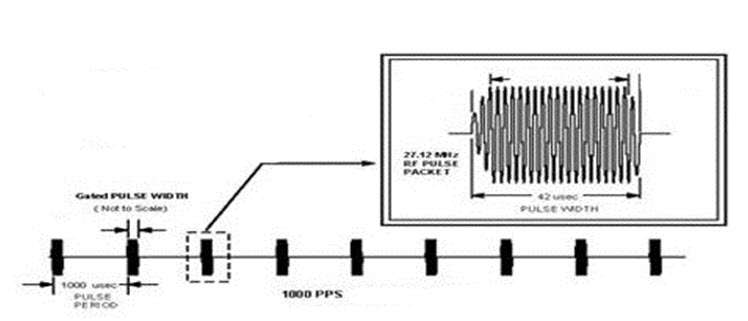Pulsed radiofrequency
Pulsed radiofrequency is the technique whereby radio frequency (RF) oscillations are gated at a rate of pulses (cycles) per second (one cycle per second is known as a hertz (Hz)). Radio frequency energies occupy 1.0 x 104 Hz to 3.0 x 1011 Hz of the electromagnetic spectrum. Radio frequency electromagnetic energy is routinely produced by RF electrical circuits connected to a transducer, usually an antenna.[1]
Pulsed radio frequency waveforms
The figure below shows an example of a generalized pulsed radio frequency waveform as seen with an oscilloscope with an antenna probe. In this example there are 1000 pulses per second (one kilohertz pulse rate) with a gated pulse width of 42 μs. The pulse packet frequency in this example is 27.125 megahertz (MHz) of RF energy. The duty cycle for a pulsed radio frequency is the percent time the RF packet is on, 4.2% for this example ([0.042 ms X 1000 pulses divided by 1000 ms/s] X 100). The pulse packet form can be a square, triangle, sawtooth or sine wave.[1] In several applications of pulse radio frequency, such as radar,[2] times between pulses can be modulated.

Use in radar
The best understood and applied use of pulse radio frequency electromagnetic energy is their use in radar (radio detection and ranging).[3] The uses of radar are diverse and applied to military, civilian and space exploration. Radar is based on the reflection or scatter of pulsed radiofrequency waves emitted from a transmitter which are then detected by an antenna which then determines the range, speed, and direction of objects. In most uses the transmitter and detector are located at the same location. Radio frequencies used with radar are from 3 megahertz (MHz) to 300 gigahertz (GHz) depending on the type and application.
Therapeutic uses
Pulsed radiofrequency fields are an emerging technology used in the medical field for the treatment of tumors, cardiac arrhythmias, chronic and post-operative pain, bone fracture, and soft tissue wounds. There are two general categories of pulsed radiofrequency field therapies based on their mechanism of action: thermal[4] and non-thermal (athermal).[5]
While thermal radiofrequency ablation for tumors and cardiac arrhythmia has been used for over 25 years, non-thermal pulsed radio frequency is currently being developed for the ablation of cardiac arrhythmias and tumors. The technique uses pulsed radio frequency energy delivered via catheter at frequencies of 300–750 kHz for 30 to 60 seconds. Thermal pulsed radio frequency takes advantage of high current delivered focally by an electrode to ablate the tissue of interest. Generally the tissue/electrode temperature reached is 60 to 75 °C resulting in focal tissue destruction. Thermal pulse radio frequency ablation has also been used for lesioning of peripheral nerves to reduce chronic pain.[6][7]
Non thermal therapeutic uses of pulsed radio frequency are currently being used to treat pain and edema, chronic wounds, and bone repair. Pulsed radiofrequency therapy technologies are described by the acronyms EMF (electromagnetic field), PEMF (pulsed electromagnetic fields),[8][9] PRF (pulsed radiofrequency fields), and PRFE[10][11](pulsed radiofrequency energy).
These technologies have been varied in terms of their electric and magnetic field energies as well as in the pulse length, duty cycle, treatment time and mode of delivery. Although pulsed radiofrequency has been used for medical treatment purposes for decades, peer reviewed publications assessing the efficacy and physiological mechanism(s) are now starting to appear addressing this technology.
Natural sources
Natural occurring sources of pulsed radiofrequency exist in the form of stars called pulsars. Pulsars were discovered in 1967 using a radio telescope.[12] These stars are thought to be rapidly spinning neutron stars. These stars have powerful magnetic fields which cause the star to emit strong radio frequencies. Different sizes of pulsars pulse at different rates.
References
- The ARRL Handbook for Radio amateurs. Newington, The American Radio Relay League, Inc. CT, 06111 USA, 1997, ISBN 0-87259-174-3
- Le Chevalier, Francois. Principles of Rader and Sonar Signal Processing, Artech House, Boston, London, 2002. ISBN 1-58053-338-8
- Skolnik, Merrill, I., Introduction to Radar System, McGraw-Hill, 2001, ISBN 0-07-066572-9
- Gazelle, G., S., Goldberg, S.N., Solbiati, L., Livraghi, T. (December 2000). "Tumor Ablation with Radio-frequency Energy". Radiology (3): 634. doi:10.1148/radiology.217.3.r00dc26633. PMID 11110923.CS1 maint: multiple names: authors list (link)
- Pilla, A., A., ed. "Mechanism and Therapeutic Applications of Time-Varying and Static magnetic Fields". third ed. Biological and Medical Aspects of Electromagnetic Fields, ed. F. Barnes, S., Greenebaum, B. 2007, CRC Press: Boca Raton. 449, ISBN 978-0-8493-9538-3
- Georgi Mikeladze; Ramon Espinal; Robert Finnegan; James Routon; Dan Martin (July 2002). "Pulsed radiofrequency application in treatment of chronic zygapophyseal joint pain☆". Pain Medicine Program, Department of Anesthesiology, Medical College of Georgia.
- Sherman, R. A., Acosta, N. M. and Robson, L. (1999). "Treatment Of Migraine With Pulsing Electromagnetic Fields: A Double-Blind, Placebo-Controlled Study". Orthopedic Surgery Service, Madigan Army Medical Center, Tacoma, Wash. Archived from the original on 2014-05-21. Retrieved 2014-05-17.CS1 maint: multiple names: authors list (link)
- Basset, C.A., "Fundamental and practical aspects of therapeutic uses of pulsed electromagnetic fields (PEMF)". Crit. Rev. Biomed Eng, pg 451-529. 1989
- Shupak, N., M., "Therapeutic Uses of Pulsed magnetic-Field Exposure: A review". Radio Science Bulletin No.307, 2003
- Porreca, E.G. and G.M. Giordano-Jablon, "Treatment of Severe (Stage III and IV) Chronic Pressure Ulcers Using Pulsed Radio Frequency Energy in a Quadriplegic Patient". ePlasty, 2008. 8: p. e49
- Frykberg, R., et al., "Cell proliferation induction: healing chronic wounds through low-energy pulsed radiofrequency". Int J Low Extrem Wounds, 2009. 8(1): p. 45-51
- Burke, B.F., Graham-Smith, F., An Introduction to Radio Astronomy, Cambridge University Press, 2001, ISBN 0-5215-5454-3